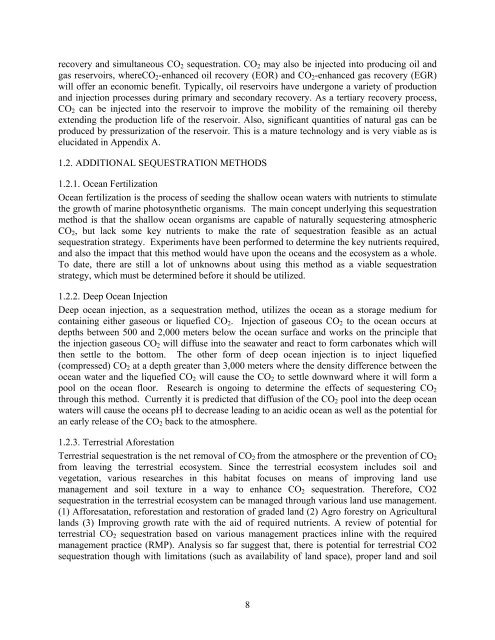CO2 Sequestration through Deep Saline Injection and ...
CO2 Sequestration through Deep Saline Injection and ...
CO2 Sequestration through Deep Saline Injection and ...
You also want an ePaper? Increase the reach of your titles
YUMPU automatically turns print PDFs into web optimized ePapers that Google loves.
ecovery <strong>and</strong> simultaneous <strong>CO2</strong> sequestration. <strong>CO2</strong> may also be injected into producing oil <strong>and</strong><br />
gas reservoirs, where<strong>CO2</strong>-enhanced oil recovery (EOR) <strong>and</strong> <strong>CO2</strong>-enhanced gas recovery (EGR)<br />
will offer an economic benefit. Typically, oil reservoirs have undergone a variety of production<br />
<strong>and</strong> injection processes during primary <strong>and</strong> secondary recovery. As a tertiary recovery process,<br />
<strong>CO2</strong> can be injected into the reservoir to improve the mobility of the remaining oil thereby<br />
extending the production life of the reservoir. Also, significant quantities of natural gas can be<br />
produced by pressurization of the reservoir. This is a mature technology <strong>and</strong> is very viable as is<br />
elucidated in Appendix A.<br />
1.2. ADDITIONAL SEQUESTRATION METHODS<br />
1.2.1. Ocean Fertilization<br />
Ocean fertilization is the process of seeding the shallow ocean waters with nutrients to stimulate<br />
the growth of marine photosynthetic organisms. The main concept underlying this sequestration<br />
method is that the shallow ocean organisms are capable of naturally sequestering atmospheric<br />
<strong>CO2</strong>, but lack some key nutrients to make the rate of sequestration feasible as an actual<br />
sequestration strategy. Experiments have been performed to determine the key nutrients required,<br />
<strong>and</strong> also the impact that this method would have upon the oceans <strong>and</strong> the ecosystem as a whole.<br />
To date, there are still a lot of unknowns about using this method as a viable sequestration<br />
strategy, which must be determined before it should be utilized.<br />
1.2.2. <strong>Deep</strong> Ocean <strong>Injection</strong><br />
<strong>Deep</strong> ocean injection, as a sequestration method, utilizes the ocean as a storage medium for<br />
containing either gaseous or liquefied <strong>CO2</strong>. <strong>Injection</strong> of gaseous <strong>CO2</strong> to the ocean occurs at<br />
depths between 500 <strong>and</strong> 2,000 meters below the ocean surface <strong>and</strong> works on the principle that<br />
the injection gaseous <strong>CO2</strong> will diffuse into the seawater <strong>and</strong> react to form carbonates which will<br />
then settle to the bottom. The other form of deep ocean injection is to inject liquefied<br />
(compressed) <strong>CO2</strong> at a depth greater than 3,000 meters where the density difference between the<br />
ocean water <strong>and</strong> the liquefied <strong>CO2</strong> will cause the <strong>CO2</strong> to settle downward where it will form a<br />
pool on the ocean floor. Research is ongoing to determine the effects of sequestering <strong>CO2</strong><br />
<strong>through</strong> this method. Currently it is predicted that diffusion of the <strong>CO2</strong> pool into the deep ocean<br />
waters will cause the oceans pH to decrease leading to an acidic ocean as well as the potential for<br />
an early release of the <strong>CO2</strong> back to the atmosphere.<br />
1.2.3. Terrestrial Aforestation<br />
Terrestrial sequestration is the net removal of <strong>CO2</strong> from the atmosphere or the prevention of <strong>CO2</strong><br />
from leaving the terrestrial ecosystem. Since the terrestrial ecosystem includes soil <strong>and</strong><br />
vegetation, various researches in this habitat focuses on means of improving l<strong>and</strong> use<br />
management <strong>and</strong> soil texture in a way to enhance <strong>CO2</strong> sequestration. Therefore, <strong>CO2</strong><br />
sequestration in the terrestrial ecosystem can be managed <strong>through</strong> various l<strong>and</strong> use management.<br />
(1) Afforesatation, reforestation <strong>and</strong> restoration of graded l<strong>and</strong> (2) Agro forestry on Agricultural<br />
l<strong>and</strong>s (3) Improving growth rate with the aid of required nutrients. A review of potential for<br />
terrestrial <strong>CO2</strong> sequestration based on various management practices inline with the required<br />
management practice (RMP). Analysis so far suggest that, there is potential for terrestrial <strong>CO2</strong><br />
sequestration though with limitations (such as availability of l<strong>and</strong> space), proper l<strong>and</strong> <strong>and</strong> soil<br />
8

















